Blog 10
I have learned a lot since the beginning of this semester. Initially I felt that most of the information in this class would be very similar to a sociology class. While the information was like the topics in a sociology class it was also more informative and detailed in how it related to individual psychology principles. I learned the most from the statistics offered in the book and was constantly surprised by the results that research found in their experiments. So far, I believe I have been able to reach course objectives and will continue to learn more as I reread the book.
My initial attitude for the course was open without any expectations. So far, I have found that my interest in social psychology has grown more than I would have thought. I believe that the information I have learned is invaluable to understanding the basic psychological principles related to individuals in social situations. I certainly would take this class again and would consider taking another psychology class related to social psychology. I feel like I have grown more efficient in time management and reading skills with every class I take including this one. One skill I believe I will use from this class is understanding how people behave and form opinions when in new situations. I believe that most of the information from this course will help me professionally whether I choose to pursue school psychology or special education teaching. I chose this image since it relates to the learning process.

Blog 9
I have learned a lot in this class so far and have made a few connections from the material to other classes I have taken. I enjoyed learning about the topics pertaining to better understanding ourselves a how we perceive ourselves in social interactions. The three topics I enjoyed the most were the sections about heuristics, self-concept, and cognitive dissonance. I have thought a lot about each of those sections from the book and constantly relate them to experiences I have had in my adult life. The assignments and blogs related to the three topics I chose have helped me further explore how they apply to social interactions. I also believe that these three topics are connected to the self and other enhancements item I chose for the first Artifact.
The assignments, and the chapter about close relationships, have helped me in my positive psychology class by relating closely to how we develop healthy social skills. In social psychology we have considered the ways that we establish relationships and what attracts us to others with close similarities. Social psychology has helped me in positive psychology by connecting those topics to how we develop positive strengths and how developing healthy coping strategies can lead to better relationships. I feel that these two classes are closely related and that by researching similar material through different angles I have been able to learn more than I could have if I had only been taking one of these classes. I chose this image since it helps represent how various topics build on each other by making a more complete way to learn.
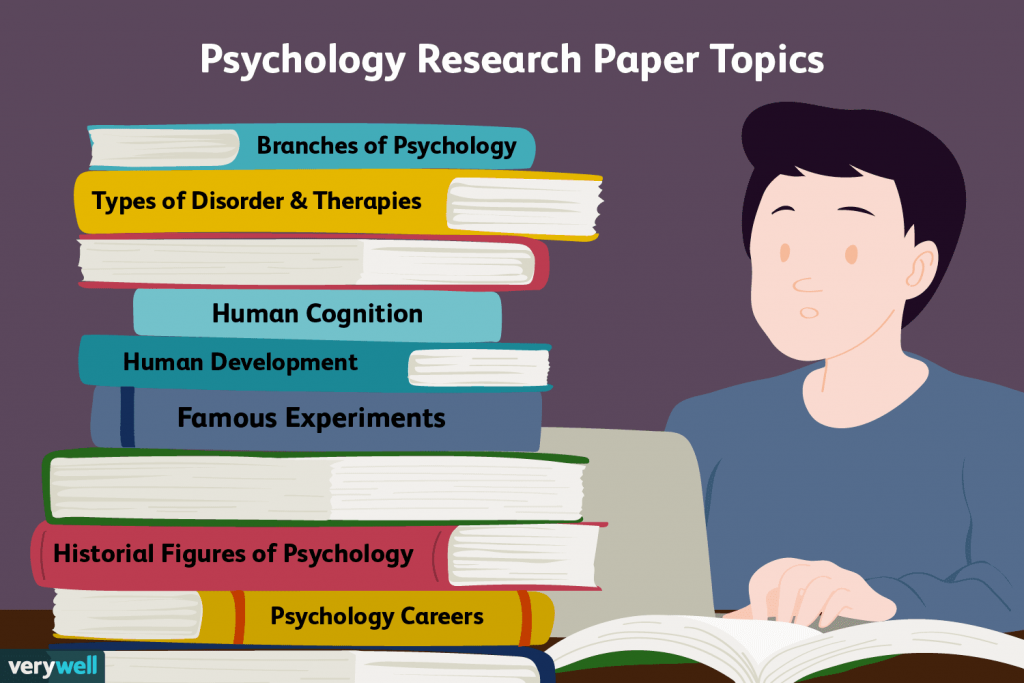
https://www.verywellmind.com/psychology-paper-topics-2795729
Blog 8
The mating article brought up some interesting points and gave me a lot to think about. It was interesting to read and think about the ways that evolutionary psychologists examine the phases of relationships. By examining the ways that different genes influence each gender there is a lot that people can consider when trying to find a partner. In the past I have not given much thought to what was driving the person I was in a relationship with other than what we had in common. When I consider some of the statistics from this article, I can relate to some of the examples and can put past experiences into perspective.
I can think of a few ways that sexual conflict has occurred in the relationships I have seen and been in. When I was younger it seemed like jealousy was a huge conflict that was dealt with very differently by men and woman. Most men I knew would act upset but not willing to talk about it. With the relationships I have been in I have noticed that when someone was upset with me that they would become more critical of my behavior. For most relationships that I have been in, I have been late to recognize a conflict and tended to think I was growing apart from the person I was seeing. In the past I accepted that my relationships weren’t working rather than being able to point out what specifically was going on. I chose this picture because it relates to the material in the article.

https://www.dailymotion.com/video/x45rt4u
Blog 7
The use of Self-regulation to manage our reactions to situations in our daily lives is very important. The connection of self-regulation to emotional intelligence is very interesting. Understanding the causes of our emotions seems to be a very important skill that we continuously develop throughout our life. Being able to control our emotions and regulate how we feel contributes to making good decisions. The diversity in our experiences as we get older means that we will also become more experienced in our approach to self-regulation.
As a person who has ADHD and has spent many years trying to make sense of how my brain processes emotions, I have found that working on emotional intelligence and methods of self-regulation is very important. Emotional intelligence to me is the ability to recognize, understand, regulate, empathize, and express emotions in a healthy and constructive way. As a rule of thumb, I believe that taking time during a situation, to make myself aware of what I am feeling will always be beneficial. I feel that one way to improve emotional intelligence is to try something new that might be “emotionally uncomfortable” (ex: participating in open mic when you have stage fright or nervousness). Experiencing something positive that might be uncomfortable to start is one way that I can think of to experience new emotions and bring an opportunity to expand emotional intelligence. I chose this image because it represents a good visualization of emotional intelligence and it’s connection to self-regulation.
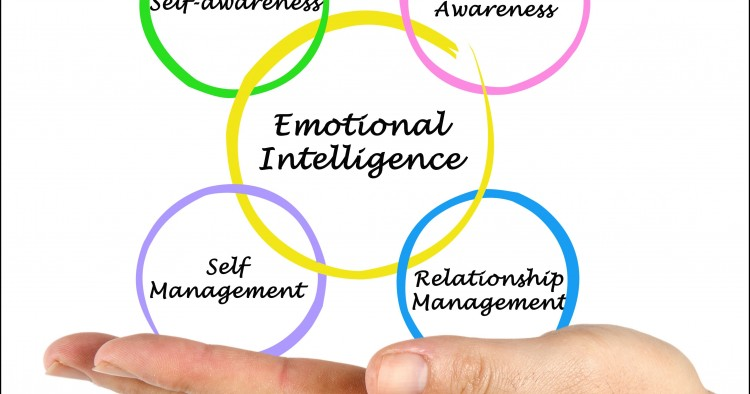
https://www.mei.edu/publications/role-emotional-intelligence-humanitarian-response
Blog 6
My reaction to this TED talk was that I am glad to see Jean Kilbourne, who understands the industry and their methods, is actively trying to educate people about how these ads are harmful. Prior to this video, I knew very little of the ways that ads were geared to influence people by stereotyping and distorting woman. I knew that photoshopping images to achieve unrealistic standards was common practice, but I did not know just how much that women are being sexualized and distorted in modern ads.
After watching this video, I gained a deeper understanding of the differences in gender representation in ads. I learned that men are treated less harshly, with ads being more suggestive than demanding. The ads directed towards woman are more intense than the ones directed at men and are to some extent a form of brainwashing. Before watching this video, I usually tried to ignore ads. I am shocked to learn that there is such a high degree of pornographic influence used in modern ads. I am glad to see that there are groups actively trying to change this practice in advertising. Here are five ads that I found which support the information in the video. These ads portray some of the device’s advertisers use to stereotype, manipulate, objectify, and distort woman.
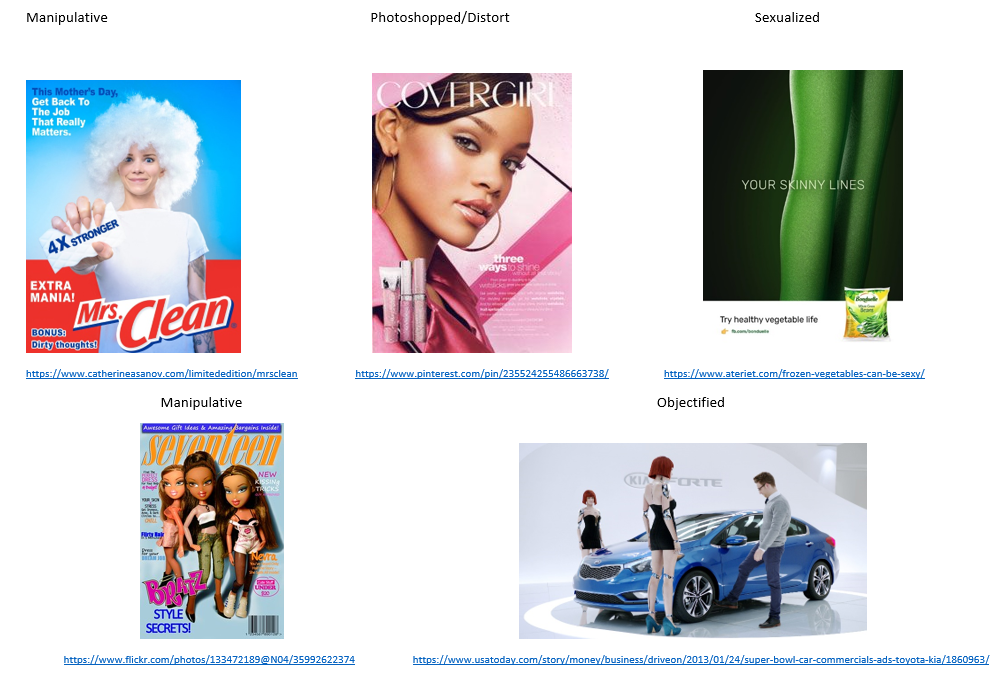
Blog 5
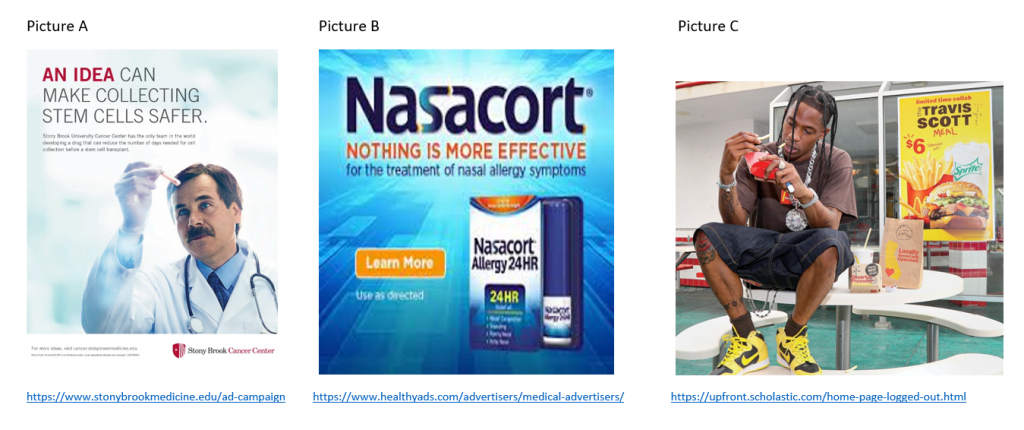
Picture A represents a credible source type advertisement. This ad appeals to trustworthiness since the organization that is involved in medical research is the one who is advertising ways to get educated. The success of their ad has the potential to help others besides themselves.
Picture B represents a non-credible source type advertisement. The group that would gain the most from the ad is also claiming that their product is the best with no deep reason as to why. Only the group responsible for the ad stands to gain anything from its success.
Picture C represents an attractive source type advertisement. The group making the ad will make the most gains without having to rely on other kinds of credible sources. This ad uses the attractive association technique of connecting their product with desirable situations.
There are many factors that can influence perceived credibility and perceived non-credible sources. People are more likely to find a source credible if the person relaying the information is perceived as trustworthy and knowledgeable. If the viewer of a source believes the person delivering the information has a personal stake in the ad then the source begins to be perceived as less trustworthy. I believe that the use of the attractive source to be very effective since the ad is less weighted and doesn’t try to convince the viewer to change their attitude.
Blog 4
The process of reviewing the exam and searching for correct answers to missed questions has helped me better understand the material covered by the exam. During the exam it is easy to oversimplify what the possible answer is or confuse “like answers” when trying not to spend too much time on one question. When taking notes while reading it can be easy to write too much and lose track of the main points and simplifying the concepts for ease of understanding. The process of review has also helped me to tinker with my note taking while reading, to emphasize the parts that I believe will be more relevant to future exams.
Before the exam, I like to study the review sheets. For the week prior, I try to refresh my memory of the main points and concepts of the chapters so that I can have them closer to mind when taking the exam. The feedback from the first exam will help me with studying and preparing for future exams. By looking at the questions that I got wrong I can see which areas of the exam were more confusing. I will have also gotten better at being more critical when thinking about the questions on future exams now that I have a had a chance to break them down and see where my thought process was wrong. I chose this image since it sums up the quality of the effort that I aim for when preparing for exams.

https://www.oakparkusd.org/worksmarter
Blog 3
The connection between music tastes and relationships is very interesting. The study pointed out an area of relationships that I had never thought of. When I reflect on the process of getting to know the people in my life, I can distinctly remember a point where musical interests became like a stepping-stone to building my initial impression of the person I was with. It makes since, looking back now, how the development of most of my relationships connects to learning about which similarities in music taste we had in common. I have also noticed that similarities in certain music taste did align with certain specific values.
Another interesting thought about the music and values connection comes from the small variations in different relationships. Similarities in values from one relationship can have a different feeling while the similarities in music taste will also differ. I like to think that the relationships that are the strongest in my life are less about how much is similar and more about sharing the most predominant values, even if we have different taste in music.
My Soundtrack:
My joy of learning: Changes (David Bowie)
My love of nature: Take Me Home, Country Roads (John Denver)
My Family: Kodachrome (Paul Simon)
My Grandparents: Blue Christmas (Elvis Presley)
My joy of playing music: Key to the Highway (Eric Clapton)
My love of classical music: Grande Valse brillante Op 18 by Fr Chopin
I believe that the music I connect with the most, often helps me take a simple approach to not overthinking the past or obsessing about the future.

https://moonology.astrostore.net/view/outlook
Blog 2
The kind of student I like to believe I am is one who is flexible and proactive in their studies. I believe I am honest to myself about my abilities and able to adjust to achieve difficult tasks if I give myself enough time to do them. As far confidence as a student, I believe I am at a moderate level with room to grow. While I might find myself overwhelmed from time to time, I find that I can achieve at least the bare minimum if I handle and manage stress.
I believe that time is the greatest factor in possibly increasing my confidence level. With more experience managing stress and developing coping tools I can become better at working “smarter not harder”. On the self-efficacy scale, I scored a 3.0 and believe this to be a fair result. In relation to task accomplishments I believe attitude and confidence play a huge factor in creating motivation and help difficult tasks easier to process. I chose these photos because they represent the way I try to work on as much as I can.
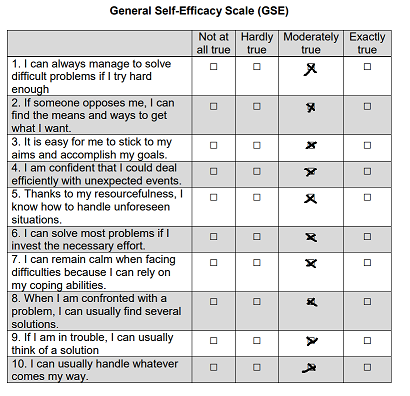

https://vocal.media/education/studying
Blog 1
The course objectives sum up some of the topics I am interested in learning about for this course. In the future I hope to use insight from this class to help promote healthier relationships and interactions with the people in my life. By gaining a better understanding of what mental processes people experience in perceiving others around us, I hope that I will be able to be more empathetic and considerate before jumping to conclusions. I expect that by the end of this course I will have a better understanding of myself and the mental processes that I use.
By taking this course I am hoping to gain a better approach to understanding other people’s behavior that I might not understand. I also hope that what I learn can be helpful should I go on to become a School Psychologist. During this semester I will use discipline and time management techniques to help ensure that I am able to lean as much as possible and complete all my assignments. I will also take my time to process and understand the instructions and objectives for this course when completing my studies.
Knowledge is Power
I chose this image represent the importance of knowledge as a way to grow and better ourselves.
